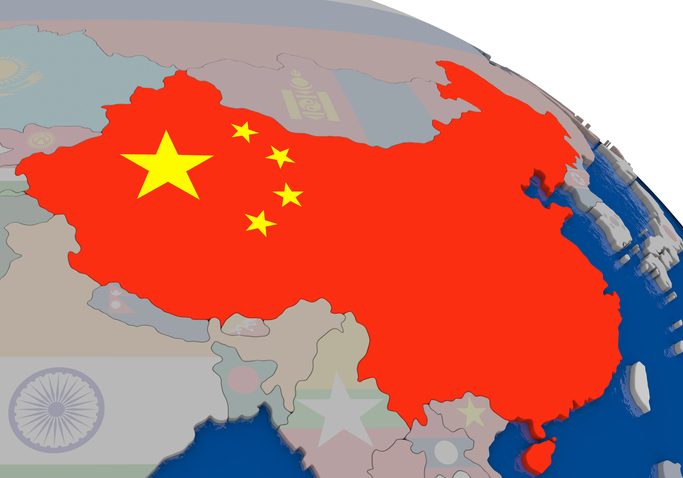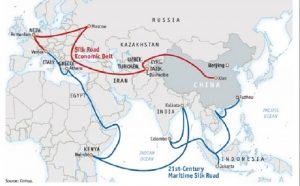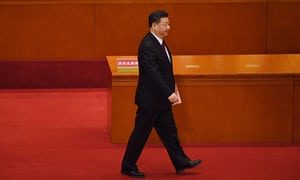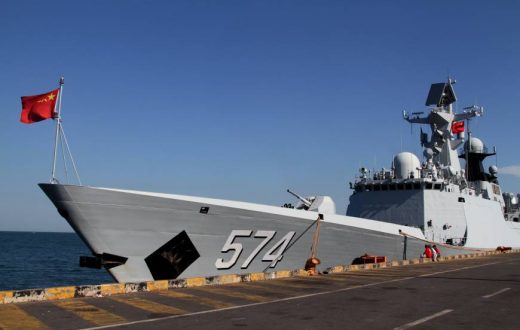World today is believed to be moving from unipolarity to multipolarity. Perhaps with the rise of China, it has already taken the course. Rauch and Wurm (2013) argue that following the thoughts of unipolarity debate, the world is going to be unipolar, with the United States of America upholding, or even magnifying, its hegemonic position in the world order. While on contrary to this debate, due to the emergence of certain economic powers, a new discourse of power transition in the international order has surfaced, which talks about power transition from unipolarity to multipolarity.
According to the power realist paradigm of International Relations (IR), a state which exceeds in military strength, size of territory and population, competence and political stability, economic capacity and resource endowment, is a great power (Walt 2010, cited by Varisco, 2013). Varisco (2013) in this regard argues that a great power is assured by these characteristics to exert its political, economic, social and military power to create its influence on the global scale. The number of great powers and polarity (i-e unipolar, bipolar and multipolar) as its aftermath in the international system are determined by the power capabilities distribution.
China’s continuous economic growth has made it a great power. Increase in annual GDP growth rate, military expansion, and international trade and investments, are the factors which make China a great power. Having influence in world power politics and world order policies, what are the strategies and policies adopted by China to play its role in the world order as a great power?
In order to answer the above question, in the following paragraphs, this article aims to describe and explain the power political strategies of China. Economic, military and political strategies of China will be described, explained and discussed. Based on the preceding arguments, discussions and analyses, conclusion(s) will be drawn.
Political Power Strategies of China
Economic Strategies of China:
Economic capacity of a country is one of the characteristics of being a great power in the world. Currently, China’s economic capacity has made it evident that economically it is a great power. Morrison (2015) in this regard argues that before the commencement of liberalization of trade and economic reforms, economic policies maintained by China kept its economy not only stagnant, inefficient, poor and centrally-controlled but also isolated from other economies of the world. However, after the implementation of free-market reforms in order to open up the foreign investment and trade in 1979, China, with the annual GDP growth rate of nearly 9.66% from 1989-2017 according to Trading Economics Website, has been among the fastest growing economies of the world. It has emerged as an economic power in the recent decades. In addition to this, it is not only the largest economy of the world in terms of purchasing power parity but also the largest merchandise trader, holder of foreign exchange reserves, and manufacturer (Morrison, 2015). Furthermore, in 2016, China’s economy surpassed that of the U.S. in terms of GDP measured in purchasing power parity. Armijo & Roberts predicted it in their essay, “The Emerging Powers and Global Governance: Why the BRICS Matter,” in the year 2014 that by 2016 the economy of China would surpass that of the U.S. in terms of GDP measured in purchasing power parity. They added that China’s economy would also surpass that of the US in dollar-terms in next 10 years.
In order to prove its economic power in the world, China has started investing in other countries of Sub Saharan Africa and South Asia which is its major inroads to exert economic and political influence in these countries. According to a report by Mayer Brown (2014) written for “The Economist’s Intelligence Unit”, in the countries of Africa, China’s desire is predominant for foreign assets. One of the key findings of the report is that the largest investment destination for China is Africa. Besides this, China’s recent investment in Pakistan under China Pakistan Economic Corridor (CPEC) project is another evidence of power political strategy of China. According to “The Washington Post” report, China is investing billions of dollars in Pakistan to create an economic corridor between respective countries. Dawn News reports that initially, China planned to invest 46 billion USD with additional projects; the current worth of CPEC is 62 billion USD. “CPEC is part of China’s grand vision, known as the One Belt, One Road (OBOR) initiative. This vision extends from the Baltics in Europe to Southeast Asia and from China to Africa,” Dawn News reports.
In addition to this, according to a commentary by Angela Stanzel (2014) published in “European Council for Foreign Affairs”, after the reduction of engagement of the US and NATO forces from the war-torn land of Afghanistan, China has stepped in. There are numerous reasons behind Afghanistan being an attractive destination for Chinese investment. Because of its Central and South Asian location, the country holds importance for China. Furthermore, the natural resources of Afghanistan have also made China interested to step in the oft-argued great game. Furthermore, according to Reuters (January 2018) news report, in order to deepen its political and economic cooperation in the region, China invited Community of Latin American and Caribbean States (CELAC) member countries to be part of Chinese OBOR adding another region to the initiative.
Military Strategies of China:
According to an article published in Los Angeles Times on September 02, 2015 by Julie Makinen that with 2.3 million on the ground, air and naval serving troops, People’s Liberation Army (PLA) of China is one of the largest military forces in the world. Furthermore, she argues that even though the military of China is not going to surpass the US military anytime soon, the gap between the two armies is certainly getting closer. A major factor behind this increasing military force is China’s increasing defense budget (Makinen, 2015). An article published in CNBC website (2015) basis its arguments on a report and argues that China is going to double its defense spending by 2020. By the end of this current decade, it is forecasted that China’s annual defense budget is going to be $260 billion which was $134 billion in 2010. This increase in China’s military power worries the world in general and the U.S. in particular. Thus, Department of Defense, USA published a study report based on “Military and Security Developments Involving the People’s Republic of China 2015”. The report highlighted that in order to fight high-intensity short-duration regional conflicts; a comprehensive military modernization program is designed by China to improve its armed forces. Furthermore, it also highlighted that the primary driving force for China’s investment in the military is to prepare itself for a potential conflict with Taiwan. Other than the possibilities of Taiwan, China also increased its prominence on the preparation for the possibilities in South and the East China Sea. In the addition to this, the report emphasized that the international interests and global footprints of China are growing. The report added to this and said that the modernization program of China’s military is focusing more towards the investment for a missions’ range beyond its own borders which includes sea lane security, peacekeeping, disaster relief, humanitarian assistance, counter-piracy and power projection. The main highlight of the report was that in order to deny the challenges of benefits of modern warfare based on information, China has started centring its attention towards offensive cyber operations, electronic warfare capabilities and counter-space. Additionally to this, in order to build infrastructure and use it as bases for civil and military operations to augment its existence in areas which are significantly disputed, China has started to reclaim the land in its outpost Islands. Therefore, it can be said that China’s military strategy is to prove its power political strategy.
Bonnie S. Glaser and Mathew P. Punaiole from Centre for Strategic and International Studies (CSIS) while commenting on “Xi Jinping’s 19th Party Congress Speech” argued that Xi suggested People’s Liberation Army (PLA) to be prepared to employ military power. Moreover, “underscoring that “a military is built to fight,” Xi called on the PLA to “regard combat capability as the criterion to meet in all its work” and to focus on “winning wars” if called upon to fight,” they added. During his speech, Xi also declared that by 2035 modernization of China’s national defense and forces will be completed. By 2049 (100th year of the founding of People’s Republic of China), Xi expects the full transformation of PLA into a first-tier force. Glaser and Mathew (2017) do not consider such ambitions of Xi unusual and comment, “rising powers often seek to reinforce their expanding security needs with military might.” However, they suspect such developments of China as its desire to displace the dominant power of the U.S. in Asia.
Political Strategies of China:
John J. Mearsheimer (2010), a realist, is pessimistic about the peaceful rise of China. He argues that in order to contain its power, most of the neighbouring countries of China including Japan, India, Vietnam, South Korea, Singapore and even Russia will join the United States. This is because of the fact that the power shift from the U.S. to China may not be good for the peace in the neighbouring countries. China seems to be inspired by this view and trying to contain its neighbours by showing them a friendlier face. Thus, China tried to make its political situation better. On November 07, 2015 The Economist in this regard published an article with the title, “Reef Nuts. No more Mr Nasty Guy? China tries to be nice,” in which “China has been showing a friendlier face” was highlighted. The article talked about China’s recent regional political development and said that China was not only showing a friendlier face to Taiwan but also to Vietnam and Japan. This friendly dealing of China with its neighbouring countries was termed as high-level diplomacy which accordingly calmed some of the quarrels of China in Asia (The Economist, 2015). This behavior of China contradicted with Mearsheimer’s argument at least for some time. However, China’s political strategies have changed to a certain extent since then. China has returned to the one man rule which has already been discussed in an article entitled, “Return of One Man Rule in China,” published on April 05, 2018.
Conclusion
“China won’t seek hegemony and will continue to play its part as a major and responsible country,” said Xi during his speech on the occasion of 19th Party Congress. China is considered reluctant to seek hegemony explicitly. However, from China’s power-political strategies, mentioned above, it seems other way around. Glaser and Mathew (2017) argued the same in their analysis of Xi’s speech. So far China’s strategies are geo-economics centric and non-military intervention oriented. China also maintains friendly behaviour towards its neighbouring countries to a certain extent. China wants to maintain its sovereignty and does not allow external forces to influence its internal matter and foreign policy. China, without any doubt, poses a great challenge to the U.S. hegemony not only in Asia but also in other parts of the world. Hence, China is the main player in the changing world order from unipolarity to multipolarity.
Muhammad Murad has been writing for different magazines and blogs since 2011. He initially started writing on social issues of Pakistan and later on, he began writing on internal and external issues related to Pakistan. Currently, he is Young Diplomats’ ambassador in Pakistan. He believes in a peaceful liberal democratic world away from war and conflict which would be possible by the power of the pen, not the gun. Muhammad is a business graduate turned social scientist and aspires to be a writer.










